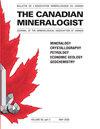Geochemistry of the Athabasca Basin, Saskatchewan, Canada, and the Unconformity-related Uranium Deposits Hosted By It
IF 1.5
4区 地球科学
Q3 MINERALOGY
引用次数: 1
Abstract
A large data set comprising near-total digestion analyses of whole rock samples from the Athabasca Basin, Saskatchewan, Canada (based principally on the Geological Survey of Canada open file 7495), containing more than 20,000 analyses, was used to define the average chemical composition of Athabasca Group sandstones and of unconformity-related uranium deposits hosted by the basin. The chemical composition of unaltered and un-mineralized Athabasca Group sandstones is dominated by Al (median Al2O3 of 1.14 wt.%), Fe (median Fe2O3 of 0.24 wt.%), and K (median K2O of 0.11 wt.%; Si was not measured), corresponding mostly to the presence of kaolin, illite, and hematite, in addition to the most-abundant quartz. The median concentration of U in the barren sandstones is 1 ppm, with 5 ppm Th, 3 ppm Pb, and 56 ppm ΣREE. Other trace elements present in significant amounts are Zr (median of 100 ppm), Sr (median of 69 ppm), and B (median of 43 ppm), corresponding to the presence of zircon, illite, and dravite. The elements most enriched in a typical Athabasca Basin unconformity-related uranium deposit relative to the barren sandstone are U (median enrichment of ×710), Bi (×175), V (×77), and Mg (×45), followed by five elements with enrichment factors between 20 and 30 (Co, Mo, K, As, and Ni). These correspond to the presence in the ore bodies of alteration minerals (dravite, kaolinite, illite, chlorite, aluminum-phosphate-sulfate minerals, and a suite of sulfide minerals) and are similar to what has been observed before. These elements are similar to the typical pathfinder elements described above known deposits, but their usefulness has to be assessed based on their relative mobility in the predominantly oxidizing Athabasca Basin sandstones.加拿大萨斯喀彻温省阿萨巴斯卡盆地的地球化学及其所含的不整合型铀矿
对加拿大萨斯喀彻温省阿萨巴斯卡盆地(Athabasca Basin, Saskatchewan)的整个岩石样本进行了近乎全面的消化分析(主要基于加拿大地质调查局公开文件7495),其中包含超过20,000次分析,用于确定阿萨巴斯卡组砂岩和盆地中与不整合相关的铀矿床的平均化学成分。未蚀变和未矿化的Athabasca群砂岩化学成分主要为Al (Al2O3中值为1.14 wt.%)、Fe (Fe2O3中值为0.24 wt.%)和K (K2O中值为0.11 wt.%);没有测量Si),主要对应于高岭土,伊利石和赤铁矿的存在,除了最丰富的石英。贫砂岩U的中位浓度为1 ppm, Th为5 ppm, Pb为3 ppm, Pb为56 ppm ΣREE。其他大量存在的微量元素有Zr(中位数为100 ppm)、Sr(中位数为69 ppm)和B(中位数为43 ppm),对应于锆石、伊利石和钛矿的存在。典型阿萨巴斯卡盆地不整合型铀矿床相对于贫砂岩富集程度最高的元素为U(中位富集度×710)、Bi (×175)、V (×77)和Mg (×45),其次为Co、Mo、K、As和Ni,富集系数在20 ~ 30之间。这些与蚀变矿物(驱动石、高岭石、伊利石、绿泥石、磷酸铝硫酸盐矿物和一套硫化物矿物)的矿体中的存在相对应,与以前观察到的相似。这些元素类似于上述已知矿床的典型探路者元素,但它们的实用性必须基于它们在主要氧化性的阿萨巴斯卡盆地砂岩中的相对流动性来评估。
本文章由计算机程序翻译,如有差异,请以英文原文为准。
求助全文
约1分钟内获得全文
求助全文
来源期刊

Canadian Mineralogist
地学-矿物学
CiteScore
2.20
自引率
22.20%
发文量
45
审稿时长
4-8 weeks
期刊介绍:
Since 1962, The Canadian Mineralogist has published papers dealing with all aspects of mineralogy, crystallography, petrology, economic geology, geochemistry, and applied mineralogy.
 求助内容:
求助内容: 应助结果提醒方式:
应助结果提醒方式:


